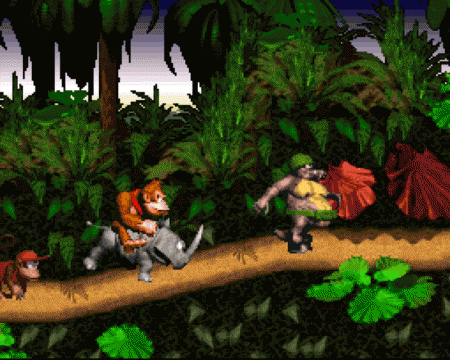
This article was originally published on November 13, 2013.
Rare’s tale begins with two brothers in the early eighties who had grown weary of toiling away making video games for other people. In 1982, Tim and Eric Stamper set out on their own to form Ashby Computers and Graphics, Ltd. The Stampers lived in England and were smitten with a system popular in that part of the world called the Sinclair ZX Spectrum, which would become their first muse. Working with just each other, their first creation was called Jetpac and published under the pseudonym Ultimate Play the Game. It was a success. For the next couple years, the Stampers continued putting out titles that captured the interests of players and critics alike, but as suddenly as they’d hit the scene, the two men relinquished control of Ultimate Play the Game and abandoned the ZX Spectrum. The reason for this drastic move was an upstart new company from the East called Nintendo.
The Stampers were taken with Nintendo’s Famicom, which was seeing success in Japan, and knew that it was the future of the industry. The brothers wanted to be ahead of the curve and get aboard Nintendo’s ship before it made the move West. As prescient as their deduction was, the brothers didn’t yet have direct access to the actual inner-workings of the console. To be able to make games for Nintendo’s new system meant having to physically dismantle and analyze the thing, along with the games themselves. With no other recourse, the brothers dedicated an entire new subdivision of Ashby Computers and Graphics to breaking down and reverse engineering Famicom from the ground up. The new venture was christened with the name Rare. The idea behind all this quasi-subterfuge wasn’t just to learn what made Famicom tick, but how to make it tick better. By the time the Stampers had finished, they were Nintendo hardware and software experts and ready to hit the ground running. Unfortunately, there was one big, ironic obstacle in their path that still needed to be overcome: Nintendo itself.
The Japanese company was infamously insular and restrictive when it came to outside developers during its rise in the late eighties. Nintendo was uncompromising and had strict rules about publishing third-party software, and the Stamper brothers weren’t entirely sure that they’d have enough clout to sway the company to play ball. With their software samples in hand, the Stampers made their way into Nintendo’s corporate headquarters with an unknown future twisting overhead. The two were actually the first Western developers to make such a bold attempt to court Nintendo’s favor, and something about their zest and clear technical prowess won the company over. The gamble had worked. Nintendo was impressed by the Stampers’ presentation and not only brought them into the fold, but gave them a large budget to work with, as well. The hardest part of the brothers’ journey was behind them. Now, it was time for them to start making games again.

At first, Rare worked on porting popular games and making titles based on licensed characters. It didn’t take long for the Stampers’ prediction that Nintendo was going to catch fire to come true. When Famicom launched in the US, it was rebranded the Nintendo Entertainment System (NES) and became a phenomenon, kickstarting the dying video game industry back into overdrive. Pundits who had criticized the Stampers’ sale of Ultimate Play the Game were suddenly eating crow as Rare was now primed to take advantage of Nintendo’s windfall. As the proliferation of NES increased, Rare began making more original titles for the system. One was R.C. Pro-Am, an isometric racing game featuring R.C. cars, powerups, and hazards that clearly later helped inspire Super Mario Kart. Another was the brutally difficult brawler Battletoads. Even when being derivative (as Battletoads was heavily influenced by the Teenage Mutant Ninja Turtles concept), Rare would add its own unique twist or touch to a game in order to make it unique.
The Stampers saw the most success for Rare on Nintendo’s console, but over a five year period in which their company produced 60 games (including occasional titles made for Sega’s Genesis and Game Gear systems), it was becoming clear that things were about to change. Nintendo was preparing to release the follow up to NES, called the Super Nintendo Entertainment System (SNES), and the Stampers weren’t prepared for the transition. Part of what made their strategy with NES work so well was that they’d spent a great deal of time and energy learning everything about it. The Stampers knew as much about how NES operated as potentially even Nintendo itself, but SNES was another story entirely and was leaving them feeling uneasy. The Stampers quickly got to work developing a plan.
Game creation was drastically cut back and the Stampers invested in cutting edge Silicon Graphics computer work stations. These computer rigs represented the best in game development technology that the industry had available, but would take some time to fully harness. While the Stampers made their adjustments, Nintendo was taking notice and found itself impressed yet again. Making such an investment as the Stampers were demonstrated an uncanny commitment to their craft that Nintendo simply couldn’t ignore. With a string of successes in the company’s past, Nintendo bought a majority stake in Rare. With the British developer officially part of the family, and after charting the progress the Stampers were making in utilizing the Silicon Graphics technology, Nintendo decided it was time to let them play with the real toys; the Stampers picked Donkey Kong.

To kick off this new era, the brothers rechristened the company Rareware and got to work on their new Donkey Kong game. Part of the reason Nintendo trusted Rare so much was that the company, both its owners and workers, were in tune with the Japanese idiosyncrasies of game design. The Stampers had spent much time learning the ins and outs of Eastern video game philosophy from years of translating Japanese games and studying Nintendo closely. If this new relationship was going to be beneficial to both parties, it only made sense for Nintendo to give Rare at least a couple keys to the kingdom to see what the developers could really do. The Stampers, well aware of why Nintendo had so sincerely embraced them, knew that if their new Donkey Kong game was going to be deemed worthy, it would have to cling to the principles that made Nintendo’s best titles so enduring.




 ShareThis
ShareThis







“Pundits who had criticized the Stampers’ sale of Ultimate Play the Game were suddenly eating crow as Rare was now primed to take advantage of Nintendo’s windfall.”